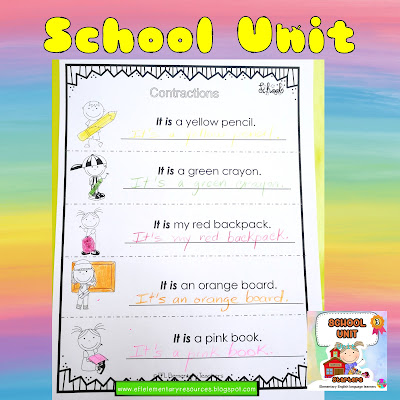This Primary English teacher resource is included in the School Unit for Elementary English Language Learners-Starters: https://www.teacherspayteachers.com/Product/School-Theme-for-Elementary-ESL-1707072
School Unit Worksheets
Students will identify classroom objects during the practice part of the lesson plan. The worksheets bring in critical thinking tasks.
School Unit Writing
Worksheets.
Students should start with completing simple sentences and then reading the
text for them to get confident in both skills and develop communicative competency. A review for expressing ownership using possessive adjective(my/your).
Play
a game after the school objects worksheet is done. Have the students complete the pencil case with five
items they want or have and write the phrases. They can get into groups of two or four.
Student1 has to guess what the other student drew, asking questions: Is there a pencil? Student 2: NO!
Here's the backpack worksheet for the students to draw school items in it and label the drawings.
The classroom objects vocabulary worksheets can be
assigned for independent practice, they can work on their own or using their
text book. Use this worksheet to keep as
a picture dictionary, either on a folder or on their notebook, a place
that students can go to and check on vocabulary when needed.
Use this pointing activity, where
students will visually identify the school words from the images.
This is a complete the words with
the vowels as a spelling practice. Students can cut the words into
cards. Play Show me or Point to: Point to the pen!
They can also place all the cards
into alphabetical order.
Any of these worksheets can be
used to create the Bingo grid to play at any given time that you decide. Students will cut up all the word strip and
glue onto the grids. Now, you have two Bingo games to play with.
This worksheet has several words
for the students to draw
the classroom object around the word. Have your students draw even more school
objects on another piece of paper or a notebook. Have them show their creation
to the class.
Picture and Word Matching worksheet
that
includes a set of images on a separate page and corresponding words on another.
Ask students to cut the images and match to each word. This helps connect
visual cues with written language.
The word search includes common
school objects. Encourage students to say the words aloud as they find them.
This connects the word’s spelling with its pronunciation.
Read and color worksheet. We might have students that need
reinforcement on colors. Easy to do maybe at home this crayon box with the colors that they
should know at this point. This combination of reading and coloring make
learning English more engaging.
It is a good exercise to put things
into Classroom Objects categories:
colors and school objects. If it seems too crowded to complete, students can
use a bigger sheet of paper or their notebook.
This is a reading comprehension worksheet. It
contains short grammar sentences. Then, students can cut it up and make a
puzzle with the two worksheets that come with the same format. This will
reinforce the understanding of the grammatically correct sentences.
Answering
yes/no questions requires students to understand meaning, not just
memorize.
Possessive
adjectives worksheets.
They are
fundamental to forming simple sentences and expressing ownership. Without
understanding possessive adjectives, learners may struggle to communicate basic
concepts such as who owns what, such as his/her.
A worksheet with the possessive
adjective: my.
Whose worksheet. Review
"Whose" alongside possessive adjectives to form questions about
ownership. They will reinforce to ask questions like "Whose book is
this?" to inquire about possession, thereby improving their question
formation skills.
To be Questions
and short answer worksheet. Tell students that they might have noticed that there
are questions and answers in English. Here they have to match each one. Have
them go through their book and find more questions and answers like the
worksheet and make them write them down on their notebook.
A review of I am grammar structure, but with the
school objects.
Contractions: It’s Worksheet. Understanding and using common
contractions will help learners understand any written text or spoken
conversation.
Read
statements and color.
Complete the sentence with: I
have!
Writing worksheets. Draw school objects on the desk in different colors. Then, have the students write a short text of what is on the desk. With a partner, exchange and have the other person write what is on the desk from the peer.
Practice “This is” and “There
are.” Students will complete the sentences to describe singular and plural images.
Another read and complete the
worksheet. Once students are ready, challenge them to add questions. For
example, Who is she? What color is she?
A questionnaire is like conducting a
survey, asking What’s your favorite school object? Students can then,
draw the school object from the results. Perfect opportunity to practice
expressing themselves in English.
Make a list
of the school objects for the favorite items.
They have to choose from the list and draw on the graphing worksheet. Do the graph as
survey. Each student will stand up with the worksheet and say: My favorite
worksheets is the pencil. Create a
tally chart to record the number of votes for each school subject.

There
are two listening worksheets to provide your students and extra opportunity
to practice this important skill in a more relaxed way. Print the worksheets that
features a boy and a girl in a classroom. This is a combination of visual
elements such as classroom objects to help make connections between the words
and colors enhancing understanding.
Teacher: Point to
the scissors!
Students
can also say sentences for the classmates to point at.
Ask
questions: What color are the scissors?
Students: red!
Finally,
have them write sentences about the picture.
Take a look!
There is a worksheet to read and color!























.png)


.png)






















